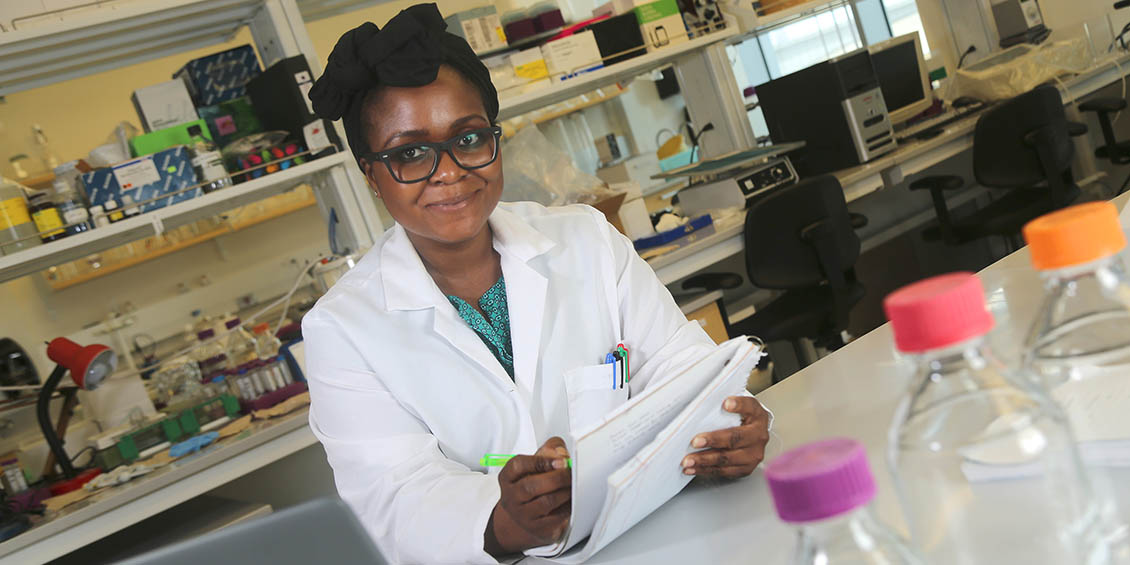Research News

Pushing Back Against the Resistance
Travel Award from Major Infectious Diseases Meeting Opens Door for PharmD/PhD Candidate to Present Research on Optimizing Drug Combinations to Fight Resistant Bacteria
UH College of Pharmacy Pharmaceutics Ph.D. candidate Henrietta Abodakpi, Pharm.D., has received a travel award from IDWeek 2018 – one of the nation’s largest gatherings of infectious diseases specialists – to present two projects aimed at optimizing drug combinations to overcome the mechanisms employed by some bacteria to resist certain types of antibiotics.
Enrolled in the college’s challenging Pharm.D./Ph.D. dual degree program, Abodakpi completed her Pharm.D. program in August 2016 and is expected to complete the Ph.D. program in December. Held Oct. 3-7 in San Francisco, Calif. this year, IDWeek is an annual meeting co-sponsored by the Infectious Diseases Society of America (IDSA), Society for Healthcare Epidemiology of America (SHEA), HIV Medicine Association (HIVMA), Pediatric Infectious Diseases Society (PIDS), IDSA Foundation, SHEA Education and Research Foundation, and the PIDS Education and Research Foundation.
Both projects to be presented at the meeting focus on optimizing the use of β-lactam/β-lactamase inhibitor combinations against extended-spectrum β-lactamase (ESBL) producing bacteria. These ESBLs are effective mediators because they inactivate the beta lactam ring required for the efficacy of antibiotics such as penicillins, cephalosporins, and aztreonam. To help restore the activity these drugs, they are paired with β-lactamase inhibitors such as tazobactam, avibactam and relebactam. However, in current clinical practice, the use of most of these β-lactamase inhibitors may not be optimized as they are dosed in a fixed ratio combination in all clinical situations.
In one project, Abodakpi and her project collaborators used a mathematical model to propose alternative dosing strategies for piperacillin/tazobactam, a β-lactam/β-lactamase inhibitor combination that has been used in clinical practice for several decades.
Using resistant strains of Klebsiella pneumoniae (K. pneumoniae) and Escherichia coli (E. coli), they illustrated that when used in the conventional 8:1 ratio, the efficacy of piperacillin/tazobactam is limited. Instead, tailoring the dose of the tazobactam for different β-lactamase producing bacteria improves the ability of the combination to suppress bacterial growth.
Project coauthors are Kai-Tai Chang, Ph.D., UHCOP postdoctoral associate; Ana María Sánchez Díaz, Ph.D., and Rafael Cantón, Pharm.D., Ph.D., both of Servicio de Microbiología, Hospital Universitario Ramón y Cajal and Instituto Ramón y Cajal de Investigación Sanitaria (IRYCIS), Madrid, Spain; and Abodakpi’s graduate advisor, Vincent H. Tam, Pharm.D., BCPS (AQ-ID), FIDSA, UHCOP professor.
In the second project, they demonstrated how this same mathematical model may be used to identify alternative inhibitor pairings for piperacillin for ESBL-producing bacteria that are not responsive to the traditional piperacillin/tazobactam combination. The results provide a novel framework for comparing the performance of different inhibitors (such as tazobactam, relebactam, avibactam), and identifying the optimal pairing of various β-lactams and β-lactamase inhibitors for individual ESBL-producing isolates.
Collaborators on the second project were Chang, Tam and Caitlin Byerly, B.S. Biology (‘17), an undergraduate research intern in Tam's lab.